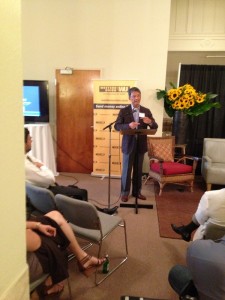
Tech titan Dado Banatao pitches the Philippines to prospective investors at June 14 conference in San Francisco. PHOTO by Harvey Barkin
SAN FRANCISCO–“So, is there still corruption in the Philippines?” The Chinese self-proclaimed would-be investor asked the panel of Silicon Valley entrepreneurs, consular staff and guests Friday at the “Latitude Longitude Emerging Markets” conference at the Philippine Consulate on June 14.
“I want to do my research. Just a yes or no, please,” he insisted.
Until the question was posed, the outlook was positive at the conference that was part of the weekend celebration of Philippine Independence. The gathering brought together trade and business experts from the consulate, the Department of Trade and Industry and the non-profit Science & Technology Advisory Council (STAC)–Silicon Valley.
All were pitching for investments for Philippine industries. The rest of the daylong conference consisted of panels on start-ups, the web, apps, capital and global markets.
The consular staff’s response to the question was perfectly diplomatic. Besides, “investors must learn that Filipinos are non-confrontational,” said Regina Jacinto-Barrientos a partner at Puyat, Jacinto & Santos.
Lots of changes
Barrientos said, “There’s still corruption (in the Philippines) but there are also lots of changes in the system.”
But Dado Banatao, managing partner at Tallwood Venture Capital, Philippine Development Foundation chairman and keynote speaker addressed the elephant in the room: “You should worry more about China, where corruption is more casual.”
It was clear from the discussions that Filipino professionals and entrepreneurs are ramping up their effort to gain new ground as traditional technology and business leaders like Japan and Hong Kong falter in today’s economy.
STAC–Silicon Valley president Christina Lakowski reminisced about old times when STAC met with start-ups “in places like basketball courts and buildings without air-conditioners.”
Things have changed in more recent times, Trade Commissioner Michael Ignacio said. “My predecessor trade diplomats had to knock on doors of major companies. When I was in Brussels and London, some Europeans probably had never heard of the Philippines.”
But when Ignacio sent out a website blast about prospects in the Philippines, he was “blown away” by the number of replies and queries he got back.
Barrientos said, “For the past two years, there have been both a spike (in the number of) foreign investors and (in the number of) Filipinos formally presenting themselves as businessmen.”
New capital sources
Even the problem capital is different now. Barrientos explained, “We have funds from foreign sources in stocks, but what we need are funds for factories.”
AyalaLand country manager Bong Gutierrez put it this way: “We don’t need shirts and shoes in balikbayan boxes. We need investments.”
But Consul General Marciano Paynor Jr. noted that even capital sourcing was evolving. Infrastructure development used to be funded by the IMF or loans or grants from Australia or Japan. “Now it is internally funded. Shoe Mart, now calling itself SMDC, funds constructions of highways and toll roads. San Miguel now maintains airports.”
Paynor also traced the country’s economic trajectory since the late President Cory Aquino restored democracy in 1986:
“Former President Fidel V. Ramos deregulated and liberated some industries (in the late 1990s.) He also privatized some state-owned corporations. When Joseph Estrada took over (in early 2000) he took goods from farms to road markets and developed irrigation systems. Former President Gloria Macapagal-Arroyo was instrumental in promoting toll roads and nautical highways. The value added tax reform law in 2005 gave 12 percent of what was sold to the government, providing it with needed funds. The current President Noynoy Aquino brought about more schools, airports and a lmorer public- -private industry partnerships. There is also transparency, accessibility and good governance.”
With world news previously focused on graft and corruption, high-profile kidnappings for ransom and calamities like floods, volcano eruptions and earthquakes, only a few saw the Philippine economy’s steady climb to economic recovery. It was like sunlight bursting out of the clouds.
In fact, Stanford University’s Dr. Richard Dasher said, “The Philippines Gross Domestic Product (GDP) growth rate increased from 6.6 percent last year to 7.9 percent. Compare that to the rest of the world at about 5.5 percent down to 3.3 percent. China’s GDP went from 9.5 percent to 7.5 percent.”
Lakowski referred to the BBB+ stable investment rating by Fitch, which rates countries by their credit rating, similar to Standard & Poor’s and Moody’s.
Youthful labor force
But perhaps the most noteworthy factor in the Philippine economy’s fast rise is its youth, Paynor said, noting that 50 percent of the population was younger than 25 years.
Barrientos added that 60 percent of the electorate would be 25 years old by 2016. “They are connected and mobile with information available at their fingertips.” When they vote for the new three-year term president, it would be with the mind set for new values, trends and a fresh business outlook.
Dasher said, “What’s exciting about the Philippines is that its young people are very entrepreneurial. From 2000 to 2010, the number of IT students enrolled in universities rose from 26,000 to 45,000 a year. These are not caregivers anymore.”
Still, Dasher cautioned, “The median income in China is about $12,000 a year. Compare that to the Philippines’ at $4,500 a year.”
Away from knock-offs
Dennis Fernandez, STAC–Sunnyvale president, pointed out a paradigm shift in knock-offs. The Philippines, he reported, was “investing to be a center of patent research, to understand previous technology in collaboration with ASEAN patent office.”
Trade Commissioner Ignacio added that the country had signed on to the Madrid Protocol to get trademark protection for most of the world.
The Philippines contributes more contents in creative industries, Paynor added, reporting that the U.S. subcontracts a lot of software requirements to the Philippines.
“We brought together Pixar founding member Ralph Guggenheim, filmmaker Eli Noyes and Cartoon Network’s Dave Barry (in 2012) with some University of the Philippines mass communication students. And they were amazed by the raw talent.”